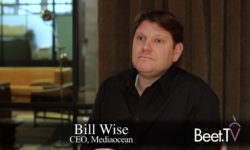What do you get when you mix the largest TV ad-monitoring service with one of the crop of TV content recognition vendors?
4C Insights calls it “enhanced audience targeting and analytics for premium channels including linear television, over-the-top (OTT) television, social, and digital media”.
Back in January, the ad intelligence company, whose Teletrax unit monitors 2,100 channels across 76 countries for both presence of program content and advertisements at the play-out end, announced it was plugging in data from Inscape, the division of TV manufacturer Vizio whose automatic content recognition (ACR) technology monitors the device end for actual viewer behavior.
What does the combination mean? Essentially, advertisers will be able to confirm not only that a certain ad or show has played out but also that a certain viewer has consumed it. In this video interview with Beet.TV, 4C chief product officer Anupam Gupta says advertisers will have two new benefits…
- New scenarios: “We’ve found a lot of interest in scenarios like, ‘Can you identify viewers who either see my ads or have completely been missed on TV that we can use to target?’ … or ‘find me households that have seen my ad, or that have seen my competitors’ ads’.”
- Creative intelligence. “Today, the way that works is focus groups – it takes a long time, you can’t swap things in and out. But, in a real-time dataset, you can do smart things like looking at ad completion rates. That can provide real-time insights to marketers.”
For Gupta, the announcement comes at the same time the opportunity within so-called “advanced TV” – with which advertisers can target individual viewers of connected video devices using more granular data – reaches a tipping point.
“Early adopters are moving toward the early majority,” he says. “We just saw some research from Forrester which said more than 50% of marketers are going to put advanced TV on their plans in 2018. Clients are deepening their usage.”
And amongst the most exciting newer trend lines Gupta sees is empowering marketers to use their own data for ad targeting.
Whilst TV ad targeting has historically been done on an age- and gender-targeted basis, advertisers are getting excited about bringing new, publicly-available datasets in to the digital TV targeting platforms now on offer.
But the ability to plug in data from their own customer databases – be it sales data, loyalty card data or more – could help advertisers both be more specific with TV spend and extend TV campaigns from TV to other digital devices when campaigns reach a maximum reach of known consumers, according to Gupta.
This video was produced at the Advanced Advertising Summit in New York. Please find more videos on this page from the Beet.TV series presented by 4C.









































